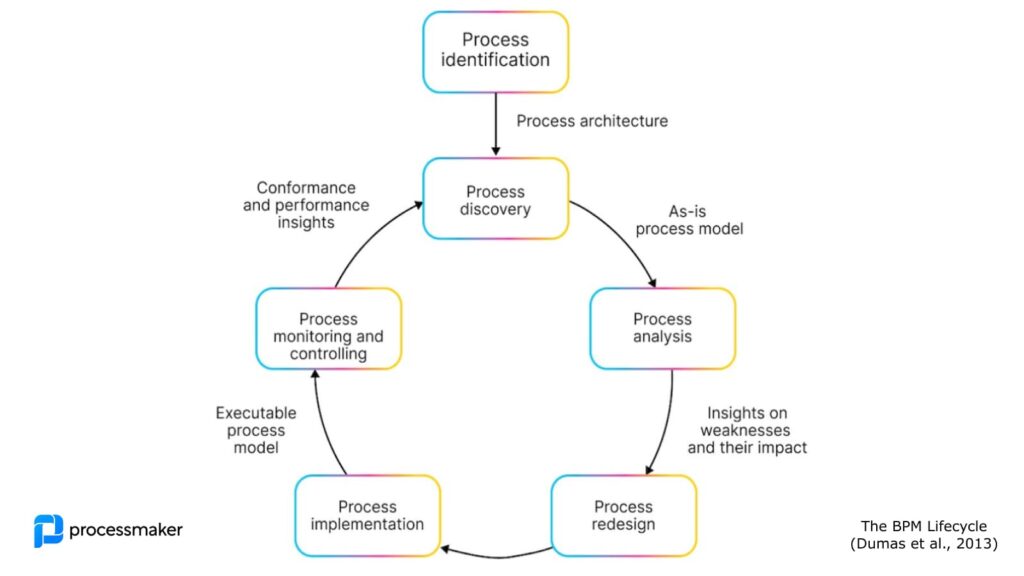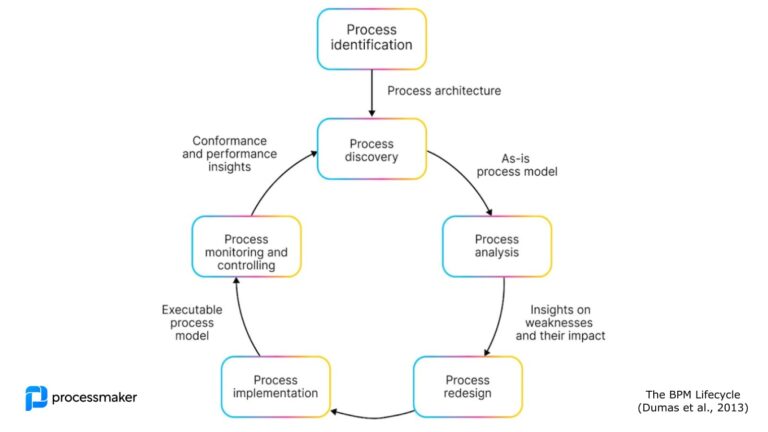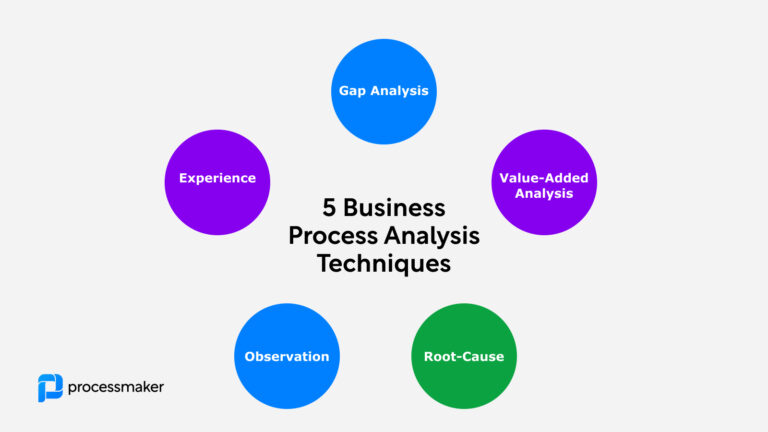Process analysis can help businesses understand how their processes work, identify bottlenecks and inefficiencies, and optimize their operations for better efficiency and cost savings. Process analysis can also help businesses identify opportunities for automation and create value for customers. Furthermore, process analysis can be used to identify risks and compliance issues, improve customer service, and ensure compliance with regulations.
What exactly is business process analysis?
Business process analysis is a method of analyzing business operations and processes to find problems and improvement opportunities. It is often based on a multi-step framework to identify, map, and improve processes within a business unit or across an organization.
Simply put, process analysis is a way of gaining insight and visibility into the steps employees and organizations perform to achieve their goals. By taking a deep dive into your current processes, you’ll see what works well, what needs to be improved, and how to achieve better business results.
A BPA is an essential aspect of business process management (BPM), a broadly used framework designed for analyzing, maintaining, and improving processes in an organization.
In this article, we’ll discuss different process analysis methods, the benefits of each, and which business process analysis tools to use.
Business process analysis vs. business analysis – who does what?
A BPA is often conducted in an enterprise business by a business process analyst – a role not to be confused with a business analyst. The key difference is that process analysts are focused on analyzing and improving processes while business analysts look at your business as a whole.
Another key role in process analysis is that of a process architect – whose responsibility may be to design, redesign, and optimize the way business processes and enterprise systems are managed, regardless of who conducts a process analysis.
Business process analysis in 7 steps

There are many ways to conduct a process analysis. Some methods follow the popular Six Sigma or Lean Six Sigma methodologies, while others may take a less rigidly defined approach. Seven common steps in the process analysis lifecycle can include:
Step 1: Process and goal identification
A good place to start a process analysis is to identify your process goals and evaluate how they fit into your organization’s goals as a whole. Doing this will help you define how you measure success, value, and prioritization of improvements.
Measurable goals for process analysis include:
- Reduced costs. Decreased costs should never mean reduced quality.
- Improved speed. Improving process speed while maintaining quality.
- Improved quality. Improving quality is about spotting and reducing time-consuming business processes that result in adverse outcomes.
Step 2: Process discovery
The process discovery phase is when you create an as-is process model of the present state of the organization’s processes. Process discovery initiatives can be both manual and automatic.
Manual approaches may involve questionnaires or interviews of key stakeholders, while automated process discovery typically involves automatic data mining of business processes or from IT systems. In both cases, the result is usually a visualization or diagram of key processes in the form of a process map.
With manual methods, it’s best to stick to one target process at a time, as mapping and analyzing processes requires a lot of work. However, automated process discovery tools are able to map complex business processes in real-time with no human involvement.
Step 3: Process analysis
A process analysis starts with identifying the processes that need to be analyzed and gathering intel on the process. Then it’s time to analyze the original process before developing new and improved processes. There are many process analysis techniques to discover.
- Value-added analysis
Value-added analysis is a method of examining each process step to identify the steps that add value and the steps that don’t. By examining individual process steps, teams can see and separate the steps that add value and those that don’t.
- GAP analysis
A gap analysis is a way to compare an organization’s current performance with its desired performance. By conducting a gap analysis, teams can see if their organization is using its resources effectively and meeting expectations.
- Root cause analysis
Conducting a root cause analysis helps identify the true cause of a business problem. Only by identifying the real and often unknown problems can teams think of solutions to fix them.
- Observation analysis
An observation analysis offers a first-hand, real-time view of a process. Observing business processes in real time shines a light on overlooked and/or undervalued process steps and shows documented but absent activities.
- Experience examination analysis
During an experience examination analysis, long-term employees share their process knowledge and the lessons they’ve learned. Expert knowledge is often underutilized, but veteran employees can share the secrets to high-level productivity and discuss previous faulty processes.
Step 4: Process Redesign
Process redesign is a complete overhaul of your company’s key business processes to improve performance measures like return on investments, a better quality of service, and reduction of costs. To redesign your processes, draw a new process diagram and share it with your organization. The diagram should:
- Show how issues are resolved
- Show new processes
- Inform teams how they can achieve proposed changes
- Show estimated costs, time, and staffing associated with this change.
Step 5: Process implementation
Process implementation is about finding what you need to change and changing it. It’s about setting instructions, coordinating and defining actionable steps, and setting targets. You can do this by:
- Informing teams about changes.
- Explain what will happen, how it’ll happen, and why.
- Assign new tasks, new software, and new top priorities.
- Prepare to see transformation in teams, management, and even entire organizations.
- Measure the changes to understand their effectiveness. Every significant change must include a well-thought-out plan.
Step 6: Process monitoring and controlling
Monitoring and analyzing processes gives you an understanding of the adjustments and improvements you might need to make and identify shadow processes.
You can identify shadow processes by:
- Looking beyond tasks and workflows and understanding the details of your daily work activities.
- A holistic view of processes prevents wasting time, resources, and opportunities.
Step 7: Go back to the beginning and around again
Keep in mind that a process analysis should focus on continuous improvement rather than act as a one-time fix.
Periodically examining and improving processes helps organizations stay on top of bottlenecks, utilize the newest and most effective software, and adopt efficient work methods. This step allows organizations to bounce back from financial shocks such as a banking crisis, unpredictable changes in currency value, and adverse global events such as the coronavirus pandemic.
Benefits of business process analysis
But why is process analysis important? Identifying and enhancing the processes that bring results means fewer bottlenecks, fewer performance issues, fewer costs, and a smoother workflow. When organizations gain insights into the so-called smaller daily tasks, they become empowered by a heightened level of understanding. A few other important reasons to conduct a process analysis are:
- Uncover hidden details
Analyzing processes helps you find and reduce the number of useless tasks holding you back and causing bottlenecks.
- Effective KPI and communication alignment
Well-understood and well-managed processes help management drive better business results.
- Transparency from historical data
Analyzing processes helps monitor team activity and identify how actions affect your business
- Improved all-round understanding and functioning
By documenting processes, everyone from veteran employees to new starters better understands what they should be doing.
- Continuous improvement and innovation
Real-time business insights bring countless improvement opportunities. For example, eliminating unnecessary processes saves time and money without investment or training.
- More informed and effective decision-making
When managers make decisions based on data, they can be sure they are making the right decision. For example, working on instinct alone, managers may lay off staff to save money, only to later realize they’ve lost highly talented team players.
The Bottom Line
A business process analysis offers organizations insights into their internal processes to identify those that provide efficiency and to improve or eliminate processes that waste time, money, and resources.
The process often changes everything from the entire organization to individual work styles, so informed decision-makers must correctly conduct it. However, getting expert advice helps make complex changes simple. Following the advice noted in this article is a great starting point.
If you’re looking to make a real change, consider using automated process analysis tools instead of long and expensive manual methods. ProcessMaker’s process analysis tool can help you analyze your workflows and get real-time data with no integration hassle.





